Hot on the heels of yesterday’s pair of hoards comes news that four Late Bronze Age metal hoards have been unearthed near Gannat in central France. There are hundreds of bronze artifacts in these hoards, so many that the site contains by far the largest grouping of Bronze Age metal objects ever discovered in France. In fact, it is one of the richest Bronze Age metal deposit sites ever discovered in Europe.
The first known hoard at the site was plundered in 2017 by looters so unfortunately the precise location of the find is unknown and cannot be archaeologically investigated. It is now in the collection of the Anne de Beaujeu Museum in Moulins. To prevent the site’s utter despoliation by treasure hunters, an official archaeological excavation began in 2019 and has been ongoing since then.
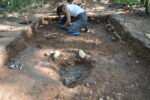 The team discovered the remains of an unusually large fortified settlement dating to around 800 B.C., the end of the Bronze Age. The 30-hectare settlement was defended by a double row of ramparts, probably a wooden palisade with earthenware ditch, and dry stone walls estimated to have been 20 feet high.
The team discovered the remains of an unusually large fortified settlement dating to around 800 B.C., the end of the Bronze Age. The 30-hectare settlement was defended by a double row of ramparts, probably a wooden palisade with earthenware ditch, and dry stone walls estimated to have been 20 feet high.
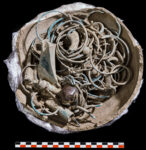 Archaeologists found the first legally excavated hoards in 2020. The two large metal deposits were perfectly intact, which is extremely rare with hoards from this time period. They were still contained inside decorated pottery vessels. To preserve the contents and pots, the hoards were removed en bloc, CT scanned and then excavated in laboratory conditions.
Archaeologists found the first legally excavated hoards in 2020. The two large metal deposits were perfectly intact, which is extremely rare with hoards from this time period. They were still contained inside decorated pottery vessels. To preserve the contents and pots, the hoards were removed en bloc, CT scanned and then excavated in laboratory conditions.
Each vessel held dozens of bronze pieces, almost all of them whole and 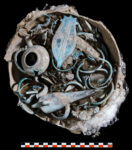 unbroken. There are weapons — axes, knives, daggers, spear tips — jewelry — bracelets, pendants, belt buckles — and fittings from chariots and horse harnesses. The objects were carefully arranged in the same way in both hoards. The jewelry was together at the bottom of the vase. A layer of sharp objects (sickles and gouges in one, swords/knives/spears in the other) was placed on top of the jewelry. The axe blades were placed above them head down. One intriguing element has never been found before in a Bronze Age hoard context: river pebbles, specifically chosen for their color. One of the hoards contained white pebbles, the other red.
unbroken. There are weapons — axes, knives, daggers, spear tips — jewelry — bracelets, pendants, belt buckles — and fittings from chariots and horse harnesses. The objects were carefully arranged in the same way in both hoards. The jewelry was together at the bottom of the vase. A layer of sharp objects (sickles and gouges in one, swords/knives/spears in the other) was placed on top of the jewelry. The axe blades were placed above them head down. One intriguing element has never been found before in a Bronze Age hoard context: river pebbles, specifically chosen for their color. One of the hoards contained white pebbles, the other red.
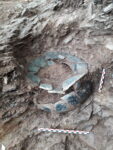 Just this month, the team unearthed two more intact metal hoards. One was inside a ceramic pot topped with a plate. The other has no container. It is a deposit of ax blades in a pit, but they are placed in the exact same way as the axes were in the 2020 finds, head down, tail up.
Just this month, the team unearthed two more intact metal hoards. One was inside a ceramic pot topped with a plate. The other has no container. It is a deposit of ax blades in a pit, but they are placed in the exact same way as the axes were in the 2020 finds, head down, tail up.
Although fragile after 2,800 years, the bronze objects are in an exceptional state of preservation. “The axes, in particular, were little or not used,” underlines Pierre-Yves Milcent, which illustrates the paleomonetary role which they played, since, as in the Gallic time, elaborate systems of exchange of values already existed in the Bronze Age. Ax blades were used as units of exchange. This point clearly illustrates that the intention of those who buried these precious objects was to sacrifice value to gods, in order to obtain their help during personal or collective crises, but also during social rites. For example inaugurating a building, a site, etc., adds Pierre-Yves Milcent, who remarks: “Sacrificing values in the earth is a European habit, which continued during the Iron Age – the Gallic period – but which has in fact existed since the Campaniforme at least.”
The discovery of such a rich vein of Bronze Age metal deposits still in situ and intact gives archaeologists a unique opportunity to study Bronze Age Europe’s practice of voluntary, organized burial of metal valuables in places where there are neither graves nor temples to explain the offerings.
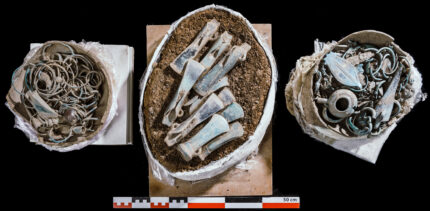
“Ax blades were used as units of exchange. This point clearly illustrates that the intention of those who buried these precious objects was to sacrifice value to gods…”
I can’t discern any basis for the certainty of that statement. Could the deposits have been a sacrifice? Of course. Could they have been something else? Of course!
Intuiting the minds of those who left no written records is a business fraught with uncertainty, and must be approached with caution.
OK, there might be hints for “sacrifice”, or those hints might be missing, i.e. we would not know. At the end of the day, it is a bronze depot, in our case almost in the form of a piggy bank.
Possibly even more interesting, are their cultural relations and trade connections.
Those hoards from Poland in the other post were on the one hand likewise from around 800BC, while the “Unetice” one, is roughly a millennium older.
:hattip:
———-
asset.museum-digital.org/san/images/201407/31001826516.jpg
upload.wikimedia.org/wikipedia/de/9/92/Stabdolch.jpg
Similar bronze deposits are found elsewhere:
de.wikipedia.org/wiki/Kategorie:Aunjetitzer_Kultur
Likewise deposited –of course not necessarily connected to those axes– from basically all over the area: en.wikipedia.org/wiki/Golden_hat
To conclude, to assume a development kicking off in Eastern Europe, might be a fair assessment. Here two burials (2nd millennium BC from Central Europe vs. fifth millennium at the Black Sea):
en.wikipedia.org/wiki/Leubingen_tumulus
en.wikipedia.org/wiki/Varna_culture